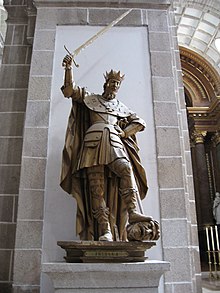Fruela I of Asturias
| Fruela I | |
|---|---|
 Statue of Fruela I in the monastery of St. Julian in Samos, Galicia. | |
| King of Asturias | |
| Reign | 757–768 |
| Coronation | 757 |
| Predecessor | Alfonso I |
| Successor | Aurelius |
| Born | c. 722 Asturias |
| Died | 14 January 768 Cangas de Onís, Asturias |
| Burial | |
| Consort | Munia of Álava |
| Issue | Alfonso II of Asturias |
| Dynasty | Astur-Leonese dynasty |
| Father | Alfonso I of Asturias |
| Mother | Ermesinda |
Fruela I (c. 722 – 14 January 768), also referred to as Froila I and nicknamed "the Cruel," was the King of Asturias from 757 until his assassination. He was the eldest son of Alfonso I and continued his father's war against the Moors. Pelayo, the founder of the Kingdom of Asturias, was his maternal grandfather.
During his reign, he suppressed uprisings from both the Basques and the Galicians; following his victory over the Basques, he took a Basque noblewoman from Alava named Munia as his wife. Basque country was relatively untouched following the revolt; on the contrary, Fruela laid waste to Galicia after suppressing the uprising.[1] He also defeated a Cordoban army led by Omar, son of Abd al-Rahman I; Omar was killed as a result of the battle.[2] The city of Oviedo was also founded during his reign when the abbot Máximo and his uncle Fromestano erected a church in honor of Saint Vincent there in 761.
Fruela personally assassinated his brother, Vimarano, leading to him being nicknamed "the Cruel." He had feared that Vimarano's popularity would lead to him taking the throne; in an act of repentance, he adopted Vimarano's son, Vermudo, as his own. The killing of Vimarano outraged the nobility, however, and he in turn was assassinated by his own men in Cangas de Onís.[3] He was succeeded by his cousin, Aurelius; his son, Alfonso, would later become King of Asturias. He and his wife Munia are buried together in the cathedral of Oviedo.[2]
References
[edit]- ^ Martínez Díez, Gonzalo (2005). El condado de Castilla, 711-1038: la historia frente a la leyenda. Marcial Pons Ediciones de Historia, S.A. p. 215. ISBN 9788495379948.
- ^ a b de Caunedo, Nicolás Castor (28 May 1854). "Un cronicón del siglo IX". Semanario Pintoresco Español. 22: 171 – via Hemeroteca Digital.
- ^ Primera crónica general : Estoria de Espan︢a que mandó componer Alfonso el Sabio y se continuaba bajo Sancho IV en 1289. Ramón Menéndez Pidal. 1906. p. 343. hdl:2027/hvd.32044018740738.
